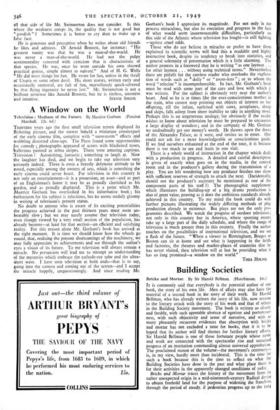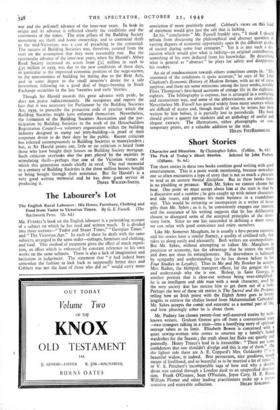Building Societies
Bricks and Mortar. By Sir Harold Bellman. (Hutchinson. 169.) IT is commonly said that everybody is the potential author of one book, the story of his own life. Men of affairs may also have the material of a second book in the story of their work. Sir Harold Bellman, who has already written the story of his life, now returns to the literary attack with the story of his work and that of others in the Building Society movement. The book is written so clearly and freshly, with such agreeable absence of egotism and portentous- ness, with such objectivity and sense of narrative, and with so many pleasantly recurrent evidences that absorption with bricks and mortar has not excluded a taste for books, that it is to be hoped that its author will find themes for further literary efforts. Sir Harold Bellman is one of those fortunate people whose Mine and work arc connected with the spectacular rise and sustained progress of an institution commanding almost universal approbation. The proclaimed reason of the volume—the movement's centenary— is, in my view, hardly more than incidental. This is the time for such a book because this is the time to reflect on what the Building Societies have done in the past and what place there ts for their activities in the apparently changed conditions of today.. Bricks and Mortar traces the history of the movement from !Is rather unexpected origin in a mid-nineteenth-century Radical dev.tee to obtain freehold land for the purpose of widening the franchise, through the period of steady. if pedestrian progress up to the 1914
war and the pell-mell advance of the inter-war years. In both its origin and its advance it reflected closely the conditions and the sentiments of the times. The trim pillars of the Building Society movement are thrift and home ownership, and to commend thrift to the mid-Victorians was a case of preaching to the converted. The success of Building Societies was, therefore, assured from the start on the assumption that they were reasonably run. But the spectacular advance of the inter-war years, when Sir Harold's Abbey Road Society increased its assets from al million in 1918 to L35 million in 1939, was due to the new conditions of those days, in particular to the improved economic position of the wage-earner, to the uncconomics of building for letting due to the Rent Acts, and in some degree to the small investor's desire for a safe investment following on a good deal of finger-burning in Stock Exchange securities in the late 'twenties and early 'thirties.
Though Sir Harold records this great advance with pride, he does not praise indiscriminately. He recognises and regrets the fact that it was necessary for Parliament by the Building Societies Act, 1939, to prescribe the protective code of practice which the Building Societies might have enforced themselves. Nevertheless, the formation of the Building Societies Association and the par- ticipation by Building Societies in the work of the Housebuilders Registration Council—a voluntary organisation within the building industry designed to stamp out jerry-building—is proof of their corporate desire to do their duty by the public. Recent criticism has referred contemptuously to Building Societies as moneylenders ; but, as Sir Harold points out, little or no criticism is heard from those who have bought their houses on Building Society mortgage. Such criticism overlooks also the part played by the societies in stimulating thrift—perhaps that one of the Victorian virtues of which this generation stands chiefly in need. The real memorial to a century of Building Societies is the three million houses bought or being bought through their assistance. But Sir Harold's is a very good written memorial and he has done good service in



































 Previous page
Previous page